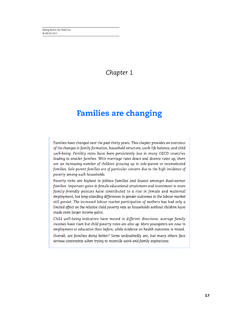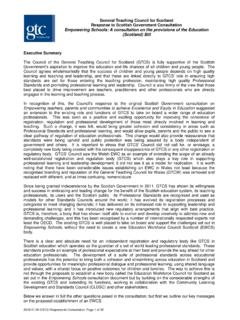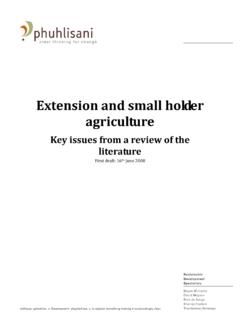Transcription of People with Disabilities in India: Some selected issues
1 People with Disabilities in People with Disabilities in india : From Commitments to india : From Commitments to OutcomesOutcomes The problem is not how to wipe out the The problem is not how to wipe out the differences but how to unite with the differences differences but how to unite with the differences intactintact .. RabindranathRabindranathTagoreTagorePhil ip OPhilip O KeefeKeefeLead Social Protection SpecialistLead Social Protection SpecialistWorld Bank, November 2007 World Bank, November 2007 The disability study The disability study Background and sourcesBackground and sourcesMain sourcesMain sources --Analysis of NSS disability rounds and Analysis of NSS disability rounds and censuscensus--Administrative dataAdministrative data--Commissioned survey of villages in UP and Commissioned survey of villages in UP and TN in 2005 ( with DFID TF financing)TN in 2005 ( with DFID TF financing)
2 --Series of background papersSeries of background papers--Reviews of secondary literatureReviews of secondary literature--Field visits to 6 states during preparationField visits to 6 states during preparation--Lots of inputs and support from NGO/DPO Lots of inputs and support from NGO/DPO community community Disability study Disability study main sectionsmain sections DefinitionsDefinitions SocioSocio--economic profileeconomic profile Attitudes to disability and disabled peopleAttitudes to disability and disabled People EducationEducation EmploymentEmployment HealthHealth Social securitySocial security Institutions and policiesInstitutions and policies AccessibilityAccessibilityKey messages of the reportKey messages of the report The number of People with Disabilities in india is The number of People with Disabilities in india is substantial and likely to grow substantial and likely to grow --disability does not disability does not go awaygo away as countries get richeras countries get richer People with Disabilities in india are subject to People with Disabilities in india are subject to deprivation in many dimensions of their livesdeprivation in many dimensions of their lives.
3 Social attitudes and stigma play an important role in Social attitudes and stigma play an important role in limiting the opportunities of disabled People for full limiting the opportunities of disabled People for full participation in social and economic life, often even participation in social and economic life, often even within their own their own families. india has one of the more progressive disability india has one of the more progressive disability policy frameworks in the developing worldpolicy frameworks in the developing world.. However, However, there remain huge challenges in there remain huge challenges in operationalizingoperationalizingthe the policy frameworkpolicy frameworkKey messages of the reportKey messages of the report Increasing the status and social and economic Increasing the status and social and economic participation of People with Disabilities would have participation of People with Disabilities would have positive effects on everyone, not just disabled positive effects on everyone.
4 Not just disabled india has a vibrant and growing disability rights india has a vibrant and growing disability rights movement and NGO/DPO and civil society movement and NGO/DPO and civil society involvement in service delivery for People with involvement in service delivery for People with While there is a long way to go, focusing on While there is a long way to go, focusing on getting getting the basics rightthe basics right on disability policy would allow for on disability policy would allow for significant progress in the foreseeable progress in the foreseeable number of People with Disabilities in The number of People with Disabilities in india is substantial and likely to growIndia is substantial and likely to grow Official disability ratesOfficial disability ratesremarkably lowremarkably low as in most of as in most of SAR SAR % of individuals in census and % % of individuals in census and % NSS BUTBUT even with this, NSS says % of rural HH and even with this.
5 NSS says % of rural HH and % of urban have a disabled member% of urban have a disabled member Major divergence on composition of disability Major divergence on composition of disability between official sourcesbetween official sourcesDisability shares by type, census and NSS, early 2000s0 102030405060 MentalVisualHearingSpeechLocomotorMultip le% of PWD popul ati onCensus ratesNSS ratesThe number of People with Disabilities in The number of People with Disabilities in india is substantial and likely to growIndia is substantial and likely to growThe report estimates a wide range of 4 The report estimates a wide range of 4--8 8 percent of the population with a disabilitypercent of the population with a disabilityWhy the difference ?Why the difference ?
6 Measurement methods used in official Measurement methods used in official surveys/censussurveys/census Based on previous reliable surveys of specific Based on previous reliable surveys of specific disabilitiesdisabilities Social attitudes and stigmaSocial attitudes and stigma International evidenceInternational evidence Much of the Much of the gapgap is driven by mental retardation is driven by mental retardation and mental health measurement and mental health measurement The Disability Profile is ChangingThe Disability Profile is ChangingShare of Disability Adjusted Life Years by Cause010203040506070Co mmu nNo n-Commu nInjury%19902020 Disability does not go away as countries Disability does not go away as countries get richerget HighIn c o meAverage disability ratepop.
7 W eighted av g. dis ability rateDisabled People are a Heterogeneous GroupDisabled People are a Heterogeneous t y020406080100 Age at t y020406080100 Age at t y020406080100 Age at onset0. 025 Densi t y020406080100 Age at onsetLocomotorMentalDisabled People are a Heterogeneous GroupDisabled People are a Heterogeneous t y020406080100 Age at onsetVisualDisabled People are a Heterogeneous GroupDisabled People are a Heterogeneous GroupExtent of disabilityExtent of disabilityShare of all PWDS hare of all PWDCan not for self even Can not for self even with aidwith care for self only Can care for self only with aidwith care for self w/out Can care for self w/out not Aid/appliance not with Disabilities are Subject to People with Disabilities are Subject to Multiple DeprivationsMultiple DeprivationsThey are PoorerThey are Poorerand have and have conversion handicapconversion handicap Households with PWD one
8 Quarter less likely to Households with PWD one quarter less likely to report 3 meals a day year roundreport 3 meals a day year round They are more likely to be in low income groupsThey are more likely to be in low income groupsFigure dence rel ati ve to averagePW DPW D s e v e r ePeople with Disabilities are Subject to People with Disabilities are Subject to Multiple DeprivationsMultiple DeprivationsThey are much more likely to be illiterate and They are much more likely to be illiterate and out of schoolout of schoolFigure *.*: Share of 6-13 year olds out of school by social category, 20050 10203040506070 All childrenMalesFemalesSCSTOBCM uslimAll disabledMentalVisualHearingSpeechLocomot orMultiple% of category out of schoolPeople with Disabilities are Subject to People with Disabilities are Subject to Multiple DeprivationsMultiple DeprivationsThey have much lower employment rates and the They have much lower employment rates and the gap to the general population has growngap to the general population has grownFigure PW DRM GENUM PW DUM GENRF PW DRF GENUF PW DUF GENA LL P W DA LL G E N% of work ing age populationFigure PW DRM GENUM PW DUM GENRF PW DRF GENUF PW DUF GENA LL P W DA LL G E N% of working age populationPeople with Disabilities are Subject to People with Disabilities are Subject to Multiple
9 DeprivationsMultiple DeprivationsThey often have low awareness of rights and They often have low awareness of rights and entitlementsentitlements 94% of HH with disabled member have not heard of PWD 94% of HH with disabled member have not heard of PWD Act in rural TN and UPAct in rural TN and UPFigure *.*: Share of PWD HHs not aware of entitlements0 102030405060708090100 PWD certificatePWD benefitFood rationAids/appliancesSubsidy on creditEmploy exchangeEducation stipendJob reservationTransport subsidy%TNUPP eople with Disabilities are Subject to People with Disabilities are Subject to Multiple DeprivationsMultiple Deprivations They are subject to strong social stigma within They are subject to strong social stigma within community and families which is often community and families which is often internalizedinternalizedFigure *.
10 *: Belief that disability a curse of God, rural UP and TN, 20050 10203040506070 All PWDUP PWDTN P W DAll non-PWDUP non-PWDTN non-PWD% of respondentsIndia has one of the more progressive india has one of the more progressive disability policy frameworks in the disability policy frameworks in the developing worlddeveloping world PWD Act, 1995 PWD Act, 1995 National Policy on Persons with Disabilities , 2005 National Policy on Persons with Disabilities , 2005 Ratification of UN Convention on Rights of Persons with Ratification of UN Convention on Rights of Persons with Disabilities (Oct. 2007) Disabilities (Oct. 2007) State Policies starting ( Chhattisgarh)State Policies starting ( Chhattisgarh) SectorSector--specific policies emerging specific policies emerging National Action Plan National Action Plan for Inclusion in Education of Children and Youth with for Inclusion in Education of Children and Youth with Disabilities Disabilities 2005/062005/06 But there remain huge challenges in But there remain huge challenges in operationalizingoperationalizingthe policy frameworkthe policy framework Inherent challenges of interInherent challenges of inter--sectoralsectoralcoordinationcoord ination Awareness among service providers, officials and Awareness among service providers.

















